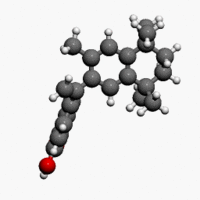Bexarotene
 | |
 | |
| Clinical data | |
|---|---|
| Trade names | Targretin |
| AHFS/Drugs.com | Monograph |
| MedlinePlus | a608006 |
| License data |
|
| Routes of administration | By mouth, topical |
| ATC code | |
| Legal status | |
| Legal status | |
| Pharmacokinetic data | |
| Protein binding | >99% |
| Metabolism | Hepatic (CYP3A4-mediated) |
| Elimination half-life | 7 hours |
| Excretion | Parent drug and metabolites are eliminated primarily through the hepatobiliary system. Less than 1% is excreted in the urine unchanged. |
| Identifiers | |
| |
JSmol) | |
| |
| |
| (verify) | |
Bexarotene, sold under the brand Targretin, is an
It was approved by the U.S.
Medical uses
Bexarotene is
It has been used off-label for non-small cell lung cancer[8] and breast cancer.[9]
Contraindications
Known contraindications include:[10]
- Hypersensitivity to the active substance or to any of the excipients in the preparation(s).
- Pregnancy and lactation
- Women of child-bearing potential without effective birth-control measures
- History of pancreatitis
- Uncontrolled hypercholesterolaemia
- Uncontrolled hypertriglyceridaemia
- Hypervitaminosis A
- Uncontrolled thyroid disease
- Hepatic insufficiency
- Ongoing systemic infection
Adverse effects
Overall the most common adverse effects are skin reactions (mostly itchiness and rashes), leucopenia, headache, weakness, thyroid anomalies (which seem to be mediated by RXR-mediated downregulation of
Interactions
Its plasma concentration may be increased by concomitant treatment with CYP3A4 inhibitors such as ketoconazole.[10] It may also induce CYP3A4, and hence CYP3A4 substrates like cyclophosphamide may have their plasma concentrations reduced.[10] Likewise consumption of grapefruit juice might increase bexarotene's plasma concentrations, hence potentially altering its therapeutic effects.[10]
Mechanism
Bexarotene is a retinoid that selectively activates retinoid X receptors (RXRs), as opposed to the retinoic acid receptors, the other major target of retinoic acid (the acid form of vitamin A).[12][13][14] By so doing it induces cell differentiation and apoptosis and prevents the development of drug resistance.[15] It also has anti-angiogenic effects and inhibits cancer metastasis.[15] The retinoic acid receptors (RARs) regulate cell differentiation and proliferation whereas RXRs regulate apoptosis.[11]
Physical properties
Bexarotene is a solid, white powder. It is poorly soluble in water; the solubility is estimated to be about 10-50 μM. It is soluble in DMSO at 65 mg/mL and in ethanol at 10 mg/mL with warming.[16]
History
The developer of bexarotene (brand name Targretin) was Ligand Pharmaceuticals, a San Diego biotech company which received FDA approval for the drug in 1999.[18] The FDA approved bexarotene on 29 December 1999.[19]
Japanese pharmaceutical Eisai bought the rights to Targretin and three other anti-cancer products from Ligand in 2006.[18] In the United States, patents on the drug expired in 2016.[18]
It received EMA approval on 29 March 2001.[20]
Early-stage preclinical studies suggested that bexarotene reduced
The results of CCMR-One, a clinical trial of the effects of bexarotene on patients with multiple sclerosis operated by the University of Cambridge,[28] have shown that the drug can cause remyelination, but will not lead to the drug being used as a therapy, due to its risk profile.[29]
References
- FDA. Retrieved 22 October 2023.
- ^ Anvisa (31 March 2023). "RDC Nº 784 - Listas de Substâncias Entorpecentes, Psicotrópicas, Precursoras e Outras sob Controle Especial" [Collegiate Board Resolution No. 784 - Lists of Narcotic, Psychotropic, Precursor, and Other Substances under Special Control] (in Brazilian Portuguese). Diário Oficial da União (published 4 April 2023). Archived from the original on 3 August 2023. Retrieved 15 August 2023.
- ^ a b c "TARGRETIN (BEXAROTENE) CAPSULE [CARDINAL HEALTH]". DailyMed. Cardinal Health. March 2006. Retrieved 12 January 2014.
- S2CID 33092727.
- PMID 32473310.
- ^ "2022 First Generic Drug Approvals". U.S. Food and Drug Administration (FDA). 3 March 2023. Archived from the original on 30 June 2023. Retrieved 30 June 2023.
- ^ "Competitive Generic Therapy Approvals". U.S. Food and Drug Administration (FDA). 3 March 2023. Retrieved 6 March 2023.
- S2CID 25374661.
- PMID 12637463.
- ^ a b c d e "Targretin Capsules - Summary of Product Characteristics". electronic Medicines Compendium. Eisai Ltd. 4 April 2013. Retrieved 14 January 2014.
- ^ ISBN 978-0-07-162442-8.
- ^ a b "Targretin (bexarotene) dosing, indications, interactions, adverse effects, and more". Medscape Reference. WebMD. Retrieved 31 January 2014.
- PMID 9147128.
- PMID 22020178.
- ^ S2CID 31266907.
- ^ "Bexarotene MSDS". LC Labs. Archived from the original on 27 January 2013.
- ^ "Lymphoma Treatment: Targretin (bexarotene)". Timeline of Innovation. SRI International. Archived from the original on 19 November 2016. Retrieved 20 September 2013.
- ^ a b c Vinluan F (12 October 2011). "Generic cancer drug from Banner aims to take on Eisai's Targretin". MedCity News. Retrieved 11 February 2012.
- ^ "Bexarotene". Drugs.com. Archived from the original on 12 January 2014. Retrieved 12 January 2014.
- ^ "Targretin : EPAR - Product Information" (PDF). European Medicines Agency. Eisai Ltd. 3 April 2013. Retrieved 12 January 2014.
- PMID 22323736.
- ^ MedicalXpress (9 February 2012). "FDA-approved drug rapidly clears amyloid from the brain, reverses Alzheimer's symptoms in mice". MedicalXpress. Retrieved 14 February 2012.
- PMID 23704552.
- PMID 23704553.
- PMID 23704554.
- S2CID 2999098.
- ^ "Anti-Cancer Drug Reverses Alzheimer's Disease In Mice". Medical News Today. 25 May 2013.
- ^ "Trials in Cambridge". Cambridge Neuroimmunology. Retrieved 25 September 2020.
- ^ "MS treatment a step closer after drug shown to repair nerve coating". the Guardian. 25 September 2020. Retrieved 25 September 2020.
External links
- "Bexarotene". Drug Information Portal. U.S. National Library of Medicine.
